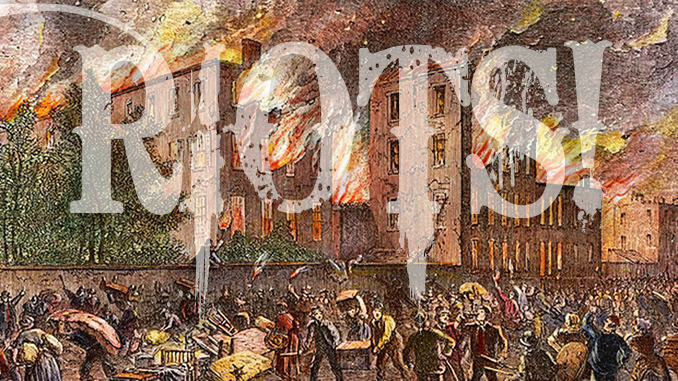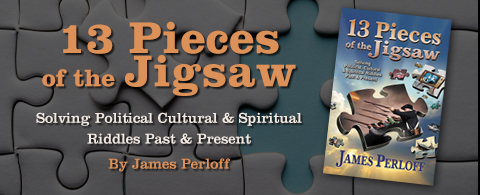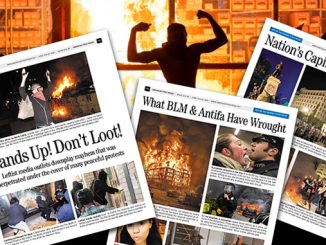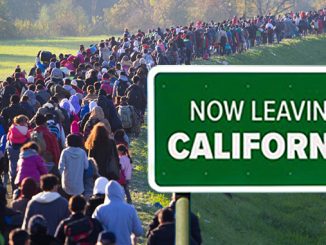
By S.T. Patrick
The president called out the military to handle the riotous protestors angered by what amounted to a battle of the entrenched and empowered versus the laboring class. America’s largest urban centers were being destroyed, and New York City became the focal point of the battles for the streets. People were being lynched on the streets by gangs of vandals, looters, and thugs, and the number of wounded and dead could only be estimated. The damage totaled over $3 million. That was 1863 money.
The New York City riots of 1863 were some of the costliest in history and it was President Abraham Lincoln who sent in the military to quell the angry rioters hell-bent on a revolution that would keep them from fighting against friends and relatives. A military draft had taken place, but it was, in essence, a draft of the poor. It was another rich man’s war fought by the poorest among us. A loophole in the draft allowed a man to pay $300 to avoid conscription ($5,000 in today’s dollars). Thus, a wealthier gentleman could avoid the fight by paying another to take his place. The bodies of the poor would line the battlefields of the Civil War on both sides.
One of the most famous riots in America occurred in the Los Angeles neighborhood of Watts in 1965. Watts had long been a low-income, minority neighborhood that had seen its residents fall victim to the stern police measures employed in poverty-stricken areas many times dominated by organized drug gangs. What began as a traffic stop to confront a drunk driver escalated into a six-day riot that cost 34 lives. It was the most dangerous case of civil unrest in Los Angeles to date, and it would remain so until the Rodney King riots of 1992.
On July 23, 1967, Detroit police raided an illegal speakeasy in one of the roughest areas of town. The police battered the inhabitants and word quickly spread to those in the neighborhood. It was excessive force, and the neighborhood quickly gathered on the streets. After a bottle was thrown through a police car window, over 400 patrolmen rushed to the scene. The protestors set fire to nearby buildings and threw rocks, bottles, and anything they could find on the ground. After five days of non-stop violence and protest, 43 people were dead and 342 injured, almost 1,400 buildings were burned, and the damage was estimated at upward of $80 million. In addition, 7,000 National Guard and Army troops had been brought in to end the violence.
For those who lived through the 1990s, the LA riots of 1992 are the most memorable of their lifetimes. Four LAPD officers were caught on camera beating Rodney King in the first nationally viewed video of its kind, kicking off the “police the police” trend. On April 29, all four officers were acquitted of criminal charges for the obvious beating. Los Angeles erupted as the anger manifest itself through looting, violence, and arson. The National Guard was called in six days later but, by the time the violence subsided, thousands had been injured and 53 killed during the riots, over 1,000 buildings had been destroyed, and the cost of the damage totaled over $1 billion—the financially costliest civil unrest in U.S. history.
There are dangers to protest. In an 1884 riot in Cincinnati, 50 people were killed, an estimated 200 lives were lost in the 1914 Ludlow, Colo. coal mine riots, and 34 were killed at the 1943 Packard riots in Detroit.
Protests and riots are the foundation of American independence, and they are as old as the flag and the eagle. The 1770 Boston Massacre took place when Bostonians were outraged that Redcoats were taking their jobs at the docks, the 1773 Boston Tea Party did over $1 million in damage in today’s money, and the 1775 Stamp Act riots occurred when the colonists were taxed without their consent.
Rioting is as much a part of American history as free speech. When those in power refuse to accept and execute their responsibilities in ways that are just, peaceful, and equitable, those affected most by their tyranny rebel. As historian Heather Cox Richardson wrote, “American rioters take to the streets for a peculiarly American reason: They believe that the government is unduly privileging someone over them. The game, they think, has been rigged, and they are the losers.“ In the Declaration of Independence, Thomas Jefferson deemed rebellion an obligation. The 2020 riots may not be the costliest, and the lives lost will not make them the deadliest. The rush to attach historicity to them is a common fault of those living in the time, but it’s a comparison only history can make.
S.T. Patrick holds degrees in both journalism and social studies education. He spent 10 years as an educator and now hosts the “Midnight Writer News Show.” His email is [email protected]. He is also an occasional contributor to TBR history magazine and the current managing editor of Deep Truth Journal (DTJ), a new conspiracy-focused publication available from the AFP Online Store.





